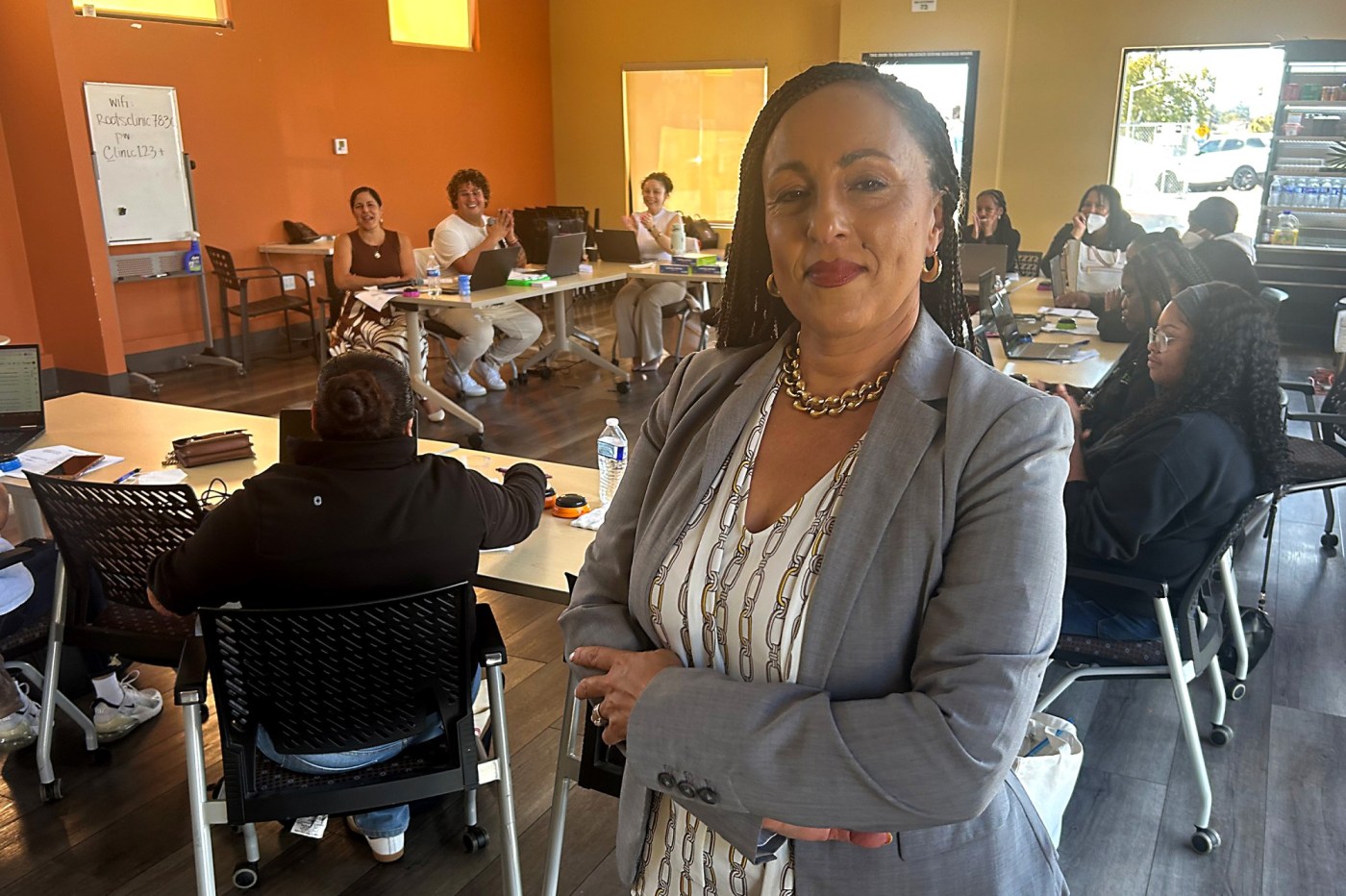
FDA’s promised guidance on pulse oximeters unlikely to end decades of racial bias
OAKLAND, Calif. — The patient was in his 60s, an African American man with emphysema. The oximeter placed on his fingertip registered well above the 88% blood oxygen saturation level that signals an urgent risk of organ failure and death.
Yet his doctor, Noha Aboelata, believed the patient was sicker than the device showed. So she sent him for a lab test, which confirmed her suspicion that he needed supplemental oxygen at home.
Months later, in December 2020, Aboelata thought back to her patient as she read a New England Journal of Medicine article showing that pulse oximeters were three times as likely to miss dangerously low blood oxygen levels in Black patients as in white ones. At a time when Black Americans were dying of covid at high rates and hospitals struggled to find beds and oxygen for those needing them, the finding exposed one of the most blatant examples of institutional racism in American health care.
“I was like, ‘Were there other patients I missed?” said Aboelata, a family physician and the CEO of Oakland-based Roots Community Health. As she shared the article with colleagues, “there was so much anger and frustration because we had every reason to believe we could rely on this device, and it was systematically not working in the population that we served.”
Related Articles
Recent recalls raise concerns about food safety, but experts credit better regulation and technology
Study: Severe COVID raised risk of heart attack, stroke as much as having heart disease
Dietary guidelines become mired in war over alcohol safety
CDC reports record drop in drug overdose deaths
Liam Payne’s ex-fiancee says he barraged her with warnings about his early death
State attorneys general and U.S. senators have pressed the FDA to take steps to eliminate pulse oximetry’s racial bias, which has caused delays in treatment and worse health outcomes, and more recently has raised concern about the reliability of hospital AI tools that draw on reams of data from the devices.
Aboelata’s clinic has sued producers and stores that sell oximeters, demanding they pull the devices or add safety warnings to the labels. Many of her patients rely on home oxygen, which requires accurate readings for Medicare to cover.
But getting rid of the devices, central to care for heart and lung diseases, sleep apnea, and other conditions, isn’t an option.
Since the 1990s, the convenient fingertip clamps have come to stand in for many uses of arterial blood gas readings, which are the gold standard for determining oxygen levels but dangerous if not done carefully. Makers of oximeters will sell around $3 billion of them this year because they are used in nearly every hospital, clinic, and long-term care facility. During the pandemic, hundreds of thousands of Americans bought them for home use.
One of them was Walter Wilson, a 70-year-old businessman in San Jose who has had two kidney transplants since 2000. Wilson contracted covid last December but delayed visiting a doctor because his home pulse oximetry readings were in the normal range.
“I’m a dark-complected Black guy. I was very sick. Had the oximeter picked that up I would have gotten to the hospital sooner,” he said.
Wilson ended up back on dialysis after several years of good health. Now he’s looking to join a class action lawsuit against the device manufacturers.
“They’ve known for years that people with darker skin get bad readings,” he said, “but they tested them on healthy white people.”
After years of little action on the issue, the FDA in 2021 sent a safety warning to doctors about oximeters. It has also funded research to improve the devices and promised to issue new guidelines for how to make them.
But as the FDA polishes draft guidelines it had hoped to publish by Oct. 1, clinicians and scientists are unsure what to expect. The agency has indicated it will recommend that manufacturers test new oximeters on more people, including a large percentage with dark-pigmented skin.
Because of industry pushback, however, the guidance isn’t expected to ask device makers to test oximeters under real-world conditions, said Michael Lipnick, a University of California-San Francisco anesthesiologist and researcher.
Hospitalized people are often dehydrated, with restricted blood flow to their extremities. This condition, known as low perfusion — essentially, poor circulation — is particularly common with cardiovascular disease, which is more prevalent in Black patients.
Pigmentation and poor perfusion “work together to degrade pulse oximetry performance,” said Philip Bickler, who directs the Hypoxia Research Lab at UCSF. “During covid, Black patients showed up sicker because of all the barriers those patients face in accessing health care. They’re showing up on death’s door, and their perfusion is lower.”
The FDA guidance isn’t expected to require manufacturers to measure how well their devices perform in patients with poor perfusion. All this means that the FDA’s efforts could lead to devices that work in healthy dark-skinned adults but do “not fix the problem,” said Hugh Cassiere, who chairs a panel for the FDA’s Medical Devices Advisory Committee, at its February meeting.
A history of inaction
Although some recent industry-sponsored studies have shown that certain devices work across skin tones, research dating to the 1980s has found discrepancies in pulse oximetry. In 2005, Bickler and other scientists at the Hypoxia Lab published evidence that three leading devices consistently failed to detect hypoxemia in darkly pigmented patients — especially those who were severely oxygen-depleted. Noting that these readings could be crucial to directing treatment, the authors called for oximeters to carry warnings.
The FDA’s response was modest. Its regulatory pathway for pulse oximeters clears them for sale as long as they show “substantial equivalence” to devices already on the market. In a 2007 draft guidance document, the FDA suggested that tests of new oximeters could “include a sufficient number of subjects with dark skin pigmentation, e.g., 30%.” However, the final guidance, issued in 2013, recommended “at least 2 darkly pigmented subjects or 15% of your subject pool, whichever is larger.” The studies were required to have only 10 subjects. And the agency did not define “dark-pigmented.”
Testing the devices involves fitting patients with masks that control the gases they breathe, while simultaneously taking pulse oximetry readings and samples of arterial blood that are fed into a highly accurate measuring device, invented by the Hypoxia Lab’s late founder, John Severinghaus.
Bickler, who evinces the bemused skepticism of a seasoned car mechanic when discussing the scores of devices his lab has tested, said “you can’t always trust what the manufacturers say.”
Their data, he said, ranges from “completely inaccurate” to “obtained under absolutely ideal conditions, nothing like a real-world performance.”
During the pandemic, a medical charity approached the lab about donating thousands of oximeters to poor countries. The oximeters it had chosen “weren’t very good,” he said. After that, the lab set up its own ratings page, a kind of Consumer Reports for pulse oximeters.
According to its tests, some expensive devices don’t work; a few of the $35 gadgets are more effective than competitors costing $350. Over a third of the marketed devices the lab has tested don’t meet current FDA standards, according to the site.
To investigate whether real-world tests of oximeters are feasible, the FDA funded a UCSF study that has recruited about 200 intensive care unit patients. The data from the study is being prepared to undergo peer review for publication, Bickler said.
He said the lab did not warm the hands of patients in the study, which is the customary practice of manufacturers when they test their devices. Warming assures better circulation in the finger the device is attached to.
“It affects the signal-to-noise ratio,” Bickler said. “Remember when car radios had AM stations, and you’d get a lot of static? That’s what poor perfusion does — it causes noise, or static that can obscure a clear signal from the device.”
Hypoxia Lab scientists — and doctors in the real world — don’t warm patients’ hands. But “the industry people can’t agree on how to handle it,” he said.
Masimo, a company that says it has the most accurate pulse oximeters on the market, would happily comply with any FDA guidance, Daniel Cantillon, Masimo’s chief medical officer, said in an interview.
How much to fix the problem?
The very best devices, according to the Hypoxia Lab, cost $6,000 or more. That points to another problem.
With better accuracy, “you are going to reduce patient access to devices for a large proportion of the world that simply can’t afford them,” Lipnick said.
Even if the FDA can’t please everyone, its anticipated call for more people with darker skin in oximetry tests will “assure there’s real diversity in the development and testing of those devices before they come to market,” Lipnick said. “That bar has been too low for decades.”
It is difficult to assess harm to individuals from faulty oximeter readings, because these errors are often one factor in a chain of events. But studies at Johns Hopkins University and elsewhere indicated that patients whose oxygen depletion wasn’t noticed — possibly thousands of them — had delayed treatment and worse outcomes.
Already, Aboelata said, a few manufacturers — Zewa Medical Technology, Veridian Healthcare, and Gurin Products — have responded to the Roots Community Health lawsuit by including warnings about their devices’ limitations.
There’s not much she and other clinicians can do in daily practice, she said, other than establish a baseline reading with each new patient and be on the lookout for notable drops. Hospitals have other tools to check oxygen levels, but correct readings are critical for outpatient care, she said. In 2022, Connecticut enacted a law banning insurers from denying home oxygen or other services based solely on pulse oximetry readings.
But “adapting around the crappy device isn’t the solution,” said Theodore Iwashyna, the Johns Hopkins Bloomberg School of Public Health professor who co-authored the New England Journal of Medicine article. “A less crappy device is the solution.”
KFF Health News is a national newsroom that produces in-depth journalism about health issues and is one of the core operating programs of KFF — the independent source for health policy research, polling and journalism.
©2024 KFF Health News. Distributed by Tribune Content Agency, LLC.


